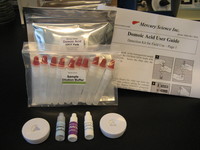Marine sensors for detecting human and wildlife health threats


An assay to detect paralytic shellfish toxins and the microscopic alga that produces them is being developed for integration into MBARI's "Environmental Sample Processor", an autonomous, in-water sensor that transmits data in near real-time. Credit: MBARI

An easy and low cost field test is being refined to detect domoic acid, a powerful neurotoxin that causes amnesic shellfish poisoning and can pose a risk to humans and marine wildlife. Credit NOAA.
The ability to rapidly and accurately monitor and assess ocean-related health threats, such as chemical contaminants, biotoxins, and harmful microorganisms, in our oceans and along our coasts lags far behind the capacity to detect physical changes in the oceans and atmosphere.
To address this need, OHHI implemented a peer-reviewed internal NOAA competition in 2010 to develop marine sensors that will detect human and animal health threats in marine environments. This program is in response to the Ocean Research Priorities Plan and Implementation Strategy (ORPPIS) "Sensors for Marine Ecosystems" near term priority and is building capacity at the OHHI Centers, across NOAA, and externally to provide early warnings of health threats.
Eight new projects were funded in 2010. These projects address research, tool/technology development, and engineering or testing of sensors to detect harmful algae and their toxins, pathogens, and chemical contaminants.
For a list of 2010 Sensors projects, click here.

Jellyfish are being explored as a biological sensor for coastal pollution and an indicator for health of endangered sea turtles. Credit: NOAA

